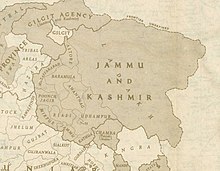Our website is made possible by displaying online advertisements to our visitors.
Please consider supporting us by disabling your ad blocker.
Poonch Jagir
| Poonch Jagir | |||||||||
|---|---|---|---|---|---|---|---|---|---|
| Jagir of Princely state of Jammu and Kashmir | |||||||||
| 1846–1947 | |||||||||
 Poonch jagir in 1946 map of princely state of Jammu and Kashmir | |||||||||
| History | |||||||||
• Established | 1846 | ||||||||
| 22 October 1947 | |||||||||
| |||||||||
| Today part of | Poonch Division, Pakistan, Poonch district, India | ||||||||
Poonch Jagir,[1] also called Poonch district,[2] was a former semi-autonomous region in the princely state of Jammu and Kashmir. The territory was divided between India and Pakistan in 1947, represented by the present-day Poonch Division of Azad Kashmir and Poonch District of Jammu and Kashmir. In 1947, the jagir was administered through four tehsils (sub-districts): Sudhanoti and Bagh in the west, and Haveli and Mendhar in the east.[3] The Poonch Town, the headquarters of the district, was located in the Haveli tehsil. The Sikh monarch, Maharaja Ranjit Singh captured the Poonch region in 1819 and gave it to the Dogra noble, Raja Dhyan Singh, as a jagir (fief). After the death of Ranjit Singh, Dhyan Singh was murdered in Sikh intrigues, and the region was transferred to Gulab Singh as part of the Treaty of Amritsar, which established Jammu and Kashmir as a princely state under British suzerainty. The jagir of Poonch continued among Dhyan Singh's descendants as a subsidiary fief of Jammu and Kashmir. In 1928, the Maharaja of Jammu and Kashmir started encroaching into the internal administration of the Poonch Jagir and, by 1947, the status of Poonch was like a regular district of Jammu and Kashmir.
In 1947, after the Partition of India, a rebellion started in the western part of the Poonch district (in the Bagh and Sudhanoti tehsils) against the Maharaja's rule and demanding accession to the newly independent Pakistan. The rebels were armed and supported by Pakistan and they evicted the State Forces, who became ensconced in their garrison at the Poonch town. The town remained besieged for almost a year, until it was relieved by the Indian Army on 20 November 1948. The western part of the district remained under the control of the rebels, who joined Pakistan as the state of Azad Kashmir. The Line of Control between the two parts of the district runs to the west of the Poonch town.
- ^ Snedden, Understanding Kashmir and Kashmiris (2015), p. 123.
- ^ Ibrahim Khan, Muhammad (1990) [1965], The Kashmir Saga (Second ed.), Mirpur: Verinag, p. 63
- ^ Snedden, Understanding Kashmir and Kashmiris (2015), p. 305
Previous Page Next Page



